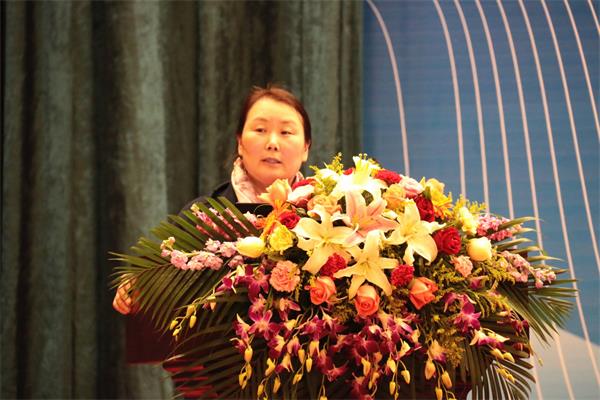崔紅娟,博士、西南大學蠶學與系統生物學研究所教授、博士生導師。首批重慶市“百名海外高層次人才集聚計畫”入選者,也是西南大學引進的首位“百人計畫”高層次創新人才,從事細胞生物學特別是幹細胞生物學領域科學研究及人才培養。
基本介紹
- 中文名:崔紅娟
- 國籍:中國
- 民族:漢族
- 性別:女
人物經歷,研究方向,主要貢獻,項目,論文,
人物經歷
1988-2000,於西南大學完成本科、碩士、博士學習;
2000-2001,第四軍醫大學博士後;
2001-2005,俄亥俄醫學院生化及腫瘤生物學助理研究員;
2005-2009,俄亥俄醫學院生化及腫瘤生物學助理教授;
2009-2010,美國克利夫蘭研究診所幹細胞生物學及再生醫學助理教授;
2010-2014,重慶市百人計畫;
2010-2014,成為重慶市巴渝學者;
2010-至今,西南大學教授,家蠶基因組生物學國家重點實驗室幹細胞研究方向總負責人。
研究方向
腫瘤生物學及腫瘤幹細胞的研究。
家蠶、昆蟲幹細胞生物學發育及細胞生物學領域。
腫瘤藥效評價及轉化醫學。
腫瘤藥效評價及轉化醫學。
申請者2010年5月回國前在美國從事多年幹細胞生物學研究, 著重探討了腫瘤幹細胞在腫瘤發生、形成上的機理,尋找腫瘤的特異性分子標誌,就腫瘤幹細胞的分子標記進行了原創性工作,發現和闡明了在腫瘤發生過程中原癌基因N-myc對幹細胞的作用機理。並系統論證了多梳族轉錄因子在神經腫瘤幹細胞的調控,為特異性阻斷此通路進行最佳化治療提供了可行性依據,為腫瘤的預後監控提供了新的重要檢測指標。
主要貢獻
項目

回國後建立了家蠶幹細胞生物學實驗室,獲得重慶市“百人計畫”和“巴渝學者”擇優支持。以幹細胞生物學作為家蠶基因組生物學國家重點實驗室發展的重要支撐方向之一,著重研究家蠶各成體幹細胞在變態發育的分子機制,開展家蠶組織、器官內幹細胞的識別、維持及其多向分化調控研究。以家蠶開展人類疾病的模型的研製,實現從昆蟲模型、到老鼠模型以及到人類疾病藥效的轉化研究。
近年在國內外重要期刊發表30篇以上,SCI文章20篇,影響因子超過100分,被SCI源文章廣泛引用。主持和參加國內973課題與美國NIH基金、美國癌症研究協會重大科研項目多項。多次被相關國際學術會議選為執行主席和特邀報告人,總計獲邀參加國際會議並做大會報告10次以上。並被多家雜誌邀請為審稿人。在美國期間,先後主持和參與了NIH、美國癌症協會和俄亥俄州多項課題的研究。在Nature Cel. Bio.,J.Biol.Chem.,Am.J.Pathol.,Molcancer Ther.等國際著名雜誌發表高水平學術論文10餘篇。
論文
- Mao L, Ding J, Zha Y, Yang L, McCarthy B, King W, Hongjuan Cui, Ding H. HOXC9 links cell cycle exit and neuronal differentiation and is a prognostic marker in neuroblastoma. Cancer Res., 2011 Jun 15;71(12):4314-24. Epub 2011 Apr 20.
- L Mao, J Ding, A Perdue, L Yang, Y Zha, M Ren, S Huang, Hongjuan Cui and H-F Ding, Cyclin E1 is a common target of BMI1 and MYCN and a prognostic marker for neuroblastoma progression. Oncogene (2011) 1–11.
- Gonit M, Zhang J, Salazar MD, Hongjuan Cui, Shatnawi A, Trumbly R, Ratnam M. Hormone depletion-insensitivity of prostate cancer cells is supported by the AR without binding to classical response elements. Mol Endocrinol. 2011 Apr;25(4):621-34. Epub 2011 Feb 17.
- Tai Li, Zhao-Bo Cui, Xiao-Xue Ke, Juan Tan, Fang-Fang Li, Ting Li, Xiang-Wei Wang, and Hong-Juan Cui. Essential Role for p53 and Caspase-9 in DNA Damaging Drug-Induced Apoptosis in Neuroblastoma IMR32 Cells. DNA and Cell Biology, 2011 Dec;30(12):1045-50 Epub 2011 may 25.
- Tai Li, Lin Wang, Xiao-xue Ke, Man Xu, Zhao-bo Cui, Hongjuan Cui, DNA damaging drugs-induced apoptosis sensitized by N-myc in neuroblastoma cells. Cell Biology International, (2012) 36, 331–337. Epub ahead of print, DOI 10.1042/CBI20110231.
- Zhichuan Li, Zhongbing Zhang, Joe X. Xie, Xin Li, Jiang Tian, Hongjuan Cui, Hanfei Ding, Joseph I. Shapiro and Zijian Xie. Na/K-ATPase mimetic pNaKtide inhibits the growth of human cancer cells. 2011,Journal of Biological Chemistry, J Biol Chem. 2011 Sep 16;286(37):32394-403. Epub 2011 Jul 22.
- Xiangwei Wang, Lunshan Xu, Jianhua Wan, Xueyang Gong, Kui Zhang, Liang Yi, Zhonghuai Xiang, Minhui Xu, Hongjuan Cui. Sonic Hedgehog pathway is essential for neuroblastoma cell proliferation and tumor growth. MCBI, DOI 10.1007/s11010-011-1222-6.
- Yang L, Hongjuan Cui, Wang Z, Zhang B, Ding J, Liu L, Ding HF. Loss of negative feedback control of nuclear factor-kappa B2 activity in lymphocytes leads to fatal lung inflammation. Am J pathol, 2010 Jun;176(6):2646-57. Epub 2010 Apr 2
- Yang H, Zhu L, Ebraheim NA, Liu X, Castillo S, Tang T, Liu J, Hongjuan Cui. 2009, Analysis of risk factors for recurrence after the resection of sacral chordoma combined with embolization. Spine J. 2009 Dec;9(12):972-80. Epub 2009 Oct 1.
- Ling Mao, Yuan-Peng Xia, Yu-Nan Zhou, Ruo-Lian Dai, Xue Yang, Shu-Jie Duan, Xian Qiao, Yuan-Wu Mei, Bo Hu and Hongjuan Cui, 2009 A critical role of Sonic Hedgehog signaling in maintaining the tumorigenicity of neuroblastoma cells Cancer Sci. 2009 Oct;100(10):1848-55. Epub 2009 Jun 26,.
- Goleeta Alam, Hongjuan Cui (co-principal author), Huilin Shi, Jane Ding, ling Mao, William A. Maltese, and Han-Fei Ding, MYCN promotes the expansion of Phox2B-positive neuronal progenitors to drive neuroblastoma development. Am J Pathol. 2009 Aug; 175(2):856-66. Epub 2009 Jul 16.
- Huilin Shi, Hongjuan Cui, Goleeta Alam, William Gunning, Andrea Nestor, David Giovannucci, Ming Zhang, Han-Fei Ding, 2008. Nestin expression defines both glial and neuronal progenitors in postnatal sympathetic ganglia, Journal of Comparative Neurology, 508: 867-878.
- Hongjuan Cui, Bo Hu, Tai Li, Jun Ma, Goleeta Alam, William T Gunning, and Han-Fei Ding, 2007. Bmi-1 is essential for the tumorigenicity of Neuroblastoma cells, American Journal of Pathology, 170 (4): 1370-1378.
- Hongjuan Cui, Jun Ma, Jane Ding, Tai Li, Goleeta Alam, and Han-Fei Ding, 2006, Bmi-1 regulates differentiation and clonogenic self-renewal of I-type neuroblastoma cells in a concentration-dependent manner, Journal of Biological Chemistry, 281 (45): 34696-34704.
- Hongjuan Cui, Tai Li, Han-Fei Ding, 2005, Linking of N-Myc to death receptor machinery in neuroblastoma cells, Journal of Biological Chemistry, 280: 9474-9481.
- Yongqing Wang, Hongjuan Cui (Co-principal author), Allen Schroering, Jane L. Ding, William S. lane, Gaël McGill, David E. Fisher and Han-Fei Ding. 2002. NF-ĸB2 p100 is a pro-apoptotic protein with anti-oncogenic function. Nature Cell Biology. 4(11): 888-93。
- Hongjuan Cui, Allen Schroering, and Han-Fei Ding. 2002. p53 mediated DNA damaging drug-induced apoptosis through a caspase-9-dependent pathway in Sh-SY5Y neuroblastoma cells. Molecular Cancer Therapeutics. 1: 679-686。

